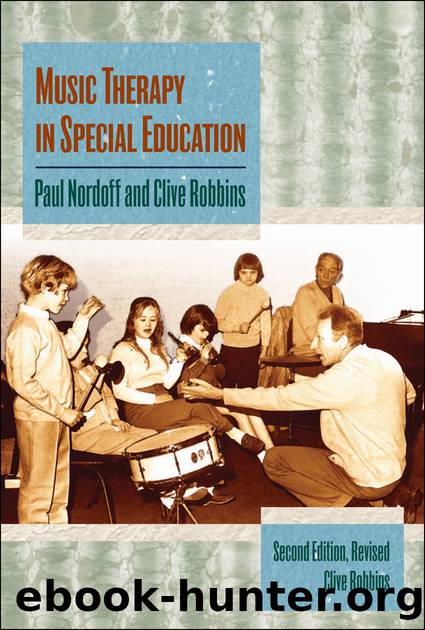Music Therapy in Special Education by Nordoff Paul;Robbins CliveA; & Clive Robbins

Author:Nordoff, Paul;Robbins, CliveA; & Clive Robbins
Language: eng
Format: epub
Publisher: Barcelona Publishers
Published: 2006-08-15T00:00:00+00:00
The Choice of Subjects for Plays
A story selected for a play should be appropriateâin maturity of content, emotionally, and in its forms of activityâfor the children who are going to work on it. It should be capable of effecting their maximum engagement and of yielding satisfying, developmental experiences. The theme and events must also be practicable for adequate and effective staging in a small number of scenes that are not too complicated for the players.
With young children the aim will most often be to create a focus of stable, enjoyable experience and activity that will arouse and coordinate the responses of individuals and stimulate social interaction. Choose stories needing little dialogue that does not refer directly to action, and those with scope for varied, purposeful activity that could be like a game. Plots should be simple: a story that follows one character through a succession of events and encounters will provide a central role for a more able child; this can carry the main action and integrate several shorter, simpler parts for other children. Stories in which a number of characters enact similar forms of action or dialogue are also suitable for this group.
When working with somewhat more advanced children, plays may be richer in theme; the range of experience given through them should be wider and aim to foster the development of emotionally perceptive understanding. Within the structure of the dramatic action the characters and scenes can express qualities and feelings such as dignity, beauty, mystery, kindness, humor, foolishness, friendliness, sadness, loneliness, anger, wonder, etc., for children to portray and experience. The older educable and play-experienced trainable children will respond purposefully to serious dramatic presentations of idealism, sacrifice, loyalty, devotion, tenderness, courage, etc., personally sustained by characters in the play.
A large part of humanityâs heritage of literature is available for dramatization into plays for handicapped children. From all over the world are folk tales and fables, mythologies, epics and legends, which have a universality in their imagery and content and a moral directness to which children respond. Religious poems and parables of many countries, the Old and New Testaments, contain inspiring, exemplifying themes. Stories may be taken from history, the biographies of famous men, and from suitable novels or tales of adventure.
The fact that in dramatizing any story you will be working it out in action widens the choice of possible subjects; many stories that children would find incomprehensible or overcomplex when told become meaningful and stimulating when developed into plays in which they participate. It does not matter if a child is unable to comprehend an entire play intellectually, provided that the part he plays has active sense for him in itself and in its connections with other characters in the action. The players experience the storyâs succession of events from within, and the significance of each childâs role in the overall play becomes more perceptible to him as the action builds up in rehearsals.
Download
This site does not store any files on its server. We only index and link to content provided by other sites. Please contact the content providers to delete copyright contents if any and email us, we'll remove relevant links or contents immediately.
Genki I by Integrated Elementary Japanese Course (with bookmarks)(227)
A microscope stage sample holder for microfluorometric measurements of biological specimen in the range of temperature between 3.5 to 300 K by Unknown(207)
The 7 Habits of Highly Effective College Students by Sean Covey(154)
Solutions to PROBABILITY AND STATISTICS WITH APPLICATIONS. A Problem Solving Text. by Leonard A. Asimow Mark M. Maxwell(107)
Music Therapy in Special Education by Nordoff Paul;Robbins CliveA; & Clive Robbins(104)
Field Guide to Human-Centered Design by Unknown(101)
Business Driven Technology, 8th Edition by Unknown(95)
Fundamentals of Human Resource Management, 7th Edition by Raymond A. Noe & John R. Hollenbeck & Barry Gerhart & Patrick M. Wright(92)
Scientific American Special Online, no. 02 (2002) by The Future of the Web(78)
Reading for Academic Success by unknow(71)
app-b by Unknown(70)
Human Resources Management Set- Concepts, Methodologies, Tools and Applications by Unknown(64)
Scientific American Special Online, no. 11 (2004) by Diet & Health(64)
Pediatric Advanced Life Support Provider Handbook by American Heart Association(61)
federal-mafia by Unknown(58)
Biblical Stories for Psychotherapy and Counseling by Kaplan Kalman;Schwartz Matthew; & Kalman J. Kaplan(58)
DI Basic and exercise Solutions by Unknown(56)
Metaphor in Psychotherapy : A descriptive and prescriptive analysis by Dennis Tay(51)
motocross championship by Unknown(51)
